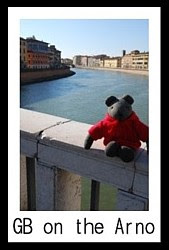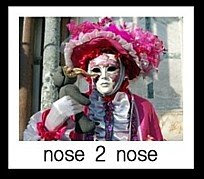 With the clock ticking down to our departure on Saturday, I asked my male god-bipedal attendant to take us on a little road trip to Pisa yesterday. Bears are exceptionally fond of road trips although that particular trait is seldom touched upon in zoological textbooks or main stream media. So off to Tuscany we went …
With the clock ticking down to our departure on Saturday, I asked my male god-bipedal attendant to take us on a little road trip to Pisa yesterday. Bears are exceptionally fond of road trips although that particular trait is seldom touched upon in zoological textbooks or main stream media. So off to Tuscany we went …
Straddling the Arno River, Pisa was put on the map by the ancient Romans – although its settlement goes much father back in time - and was once a great naval power, at times rivaling both G enoa and Venice for maritime supremacy. Its coming-up-in-the-world began in the 800’s when it rose to the challenge of marauding Saracen pirates and ended about 400 years later with a crushing military defeat headed by the Genoans.
enoa and Venice for maritime supremacy. Its coming-up-in-the-world began in the 800’s when it rose to the challenge of marauding Saracen pirates and ended about 400 years later with a crushing military defeat headed by the Genoans.
Although the city would completely fall to Florence, thanks to the Medici, it became a centre for the arts and lofty thoughts. Galileo was born here (and even conducted an experiment or two off of that tower which leans) as was tenor Andrea Bocelli, although Bocelli’s success didn’t have too much to do with the Medicis, having been born half a millennium later and all.
In its heyday, Pisa had controlling interests and enjoyed special privileges in Jerusalem, Syria, Lebanon, Palestine, Cairo, Alexandra and Constantinople. At one point, Pisa controlled Corsica and Sicily – the sacking of which paid for all those pretty buildings – including the one which leans - in its Piazza dei Miracoli, the Square of Miracles.
The Leaning Tower (or Torre pendente di Pisa) of Pisa just might be Italy’s most iconic landmark – although Romans might disagree with that. Paris has the Eiffel Tower, London has Big Ben, the U.S. has the Statue of Liberty, and Italy has this off-kilter counterpart. The tower, which is really a bell-tower or campanile for the Cathedral (yes, it’s another duomo), pretty much started leaning from Day One back on August 9th, 1173. Three tiers in to it, it was leaning. Over time and a lot of shifting soil or substrate (I’m putting on my geological hat here), the Tower found itself inclining at a rate of one millimetre a year.
to it, it was leaning. Over time and a lot of shifting soil or substrate (I’m putting on my geological hat here), the Tower found itself inclining at a rate of one millimetre a year.
Back when you humans were killing each other in the 20th century (World War II to be exact, because I know there are many other incidents for you to draw upon), the Nazis used the Tower as an observation post. The allies appointed a U.S. sergeant who had the option of launching a military strike against it. He ultimately chose not to destroy it. I hope someone gave him a medal.
In 1990, the Tower was closed so that a group of Big Brains could finally figure out ho w to stop the leaning - they did, with the result that the Tower leaned 40 centimetres less. It was reopened in 2001. My bipedal attendants and I and another 37 people – entry is restricted to 40 bears and people at a time – climbed 296 very slippery and wonky stairs to reach the top, some 55.86 metres from the ground. The views were spectacular and almost as entertaining as watching my female bipedal attendant have a meltdown on the top. Granted, the Tower’s top isn’t level (the Tower leans, you know) and the guard rails are awfully low, but still I thought she made too big a deal of it. She can be such a baby.
w to stop the leaning - they did, with the result that the Tower leaned 40 centimetres less. It was reopened in 2001. My bipedal attendants and I and another 37 people – entry is restricted to 40 bears and people at a time – climbed 296 very slippery and wonky stairs to reach the top, some 55.86 metres from the ground. The views were spectacular and almost as entertaining as watching my female bipedal attendant have a meltdown on the top. Granted, the Tower’s top isn’t level (the Tower leans, you know) and the guard rails are awfully low, but still I thought she made too big a deal of it. She can be such a baby.
Of course, everyone has to have their photo taken of them “supporting” the Leaning Tower. I normally don’t indulge in that kind of thing but I was immediately recognized (Italians know me more from my international fashion model days than my humanitarian work as a Freelance Goodwill Ambassador - Italians!) and, well, it’s just so hard to say no sometimes. Although you should always say no to drugs.
There’s a lot more I could talk about Pisa; after all, Pisa is much more than its Tower – but it’s the Leaning Tower that busloads of people come to see every year.
I’ll just finish by saying that in 2001, engineers stated that the Tower would remain stable for another 300 years. In 2008, after tweaking 70 metric tons of soil, engineers revised that to another 200 years. It’s not that I don’t trust all those Big Brains who worked on the Tower, but I’m glad that I saw it in 2009. Generally, I like to lean on the side of caution.
































